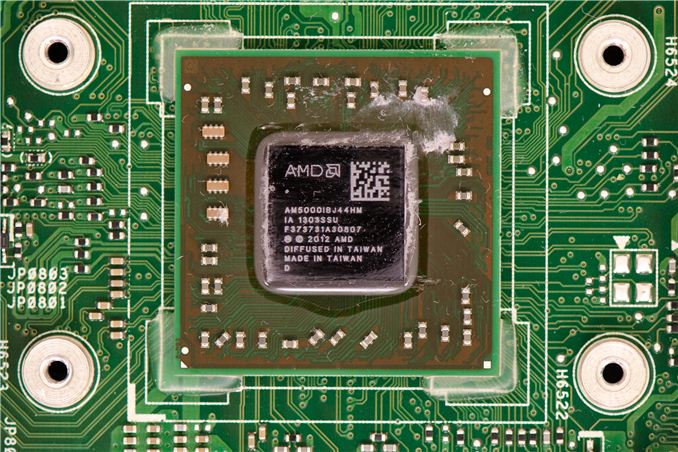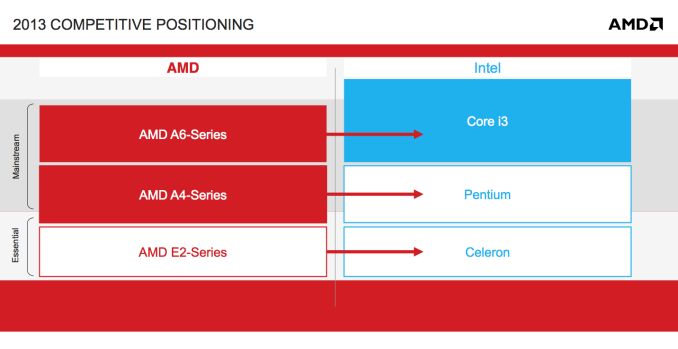The Kabini Deal: Can AMD Improve the Quality of Mainstream PCs with Its Latest APU?
by Anand Lal Shimpi on May 24, 2013 1:45 PM EST
There are two non-negotiables in building a PC these days: the cost of Intel silicon and the cost of the Windows license. You can play with everything else but Intel and Microsoft are going to get their share. Those two relatively fixed costs in the PC bill of materials can do one of two things: encourage OEMs to skimp on component cost elsewhere, or drive the entire ecosystem to supply higher quality components at lower prices. If you’ve been following the PC industry for the past decade, I think we’ve seen more of the former and less of the latter.
Apple occupying the high-end of the notebook PC space has forced many OEMs to reconsider their approach, but that’s a more recent change. What AMD seems to offer is an easier path. AMD will take less of the BoM, allowing OEMs to invest those savings elsewhere - a move Intel will never make. Given how much pressure the PC OEMs have been under for the past few years, AMD’s bargain is more appealing now than it has ever been.
With Llano and Trinity, AMD’s story was about giving up CPU performance for GPU performance. With Kabini, the deal is more palatable. You only give up CPU performance compared to higher priced parts (you gain performance compared to Atom), and you get much lower power silicon that can run in thinner/lighter notebooks. Typically at the price points Kabini is targeting (sub-$400 notebooks), you don’t get pretty form factors with amazing battery life. AMD hopes to change that.
While AMD hasn’t disclosed OEM pricing on Kabini (similarly, Intel doesn’t list OEM pricing on its mobile Pentium SKUs), it’s safe to assume that AMD will sell Kabini for less than Intel will sell its competing SKUs. If Kabini’s die size is indeed around 107mm^2, that puts it in the same range as a dual-core Ivy Bridge. AMD can likely undercut Intel a bit and live off of lower margins, but there’s one more component to think about: Ivy Bridge needs its PCH (Platform Controller Hub), Kabini does not. As a more fully integrated SoC, Kabini’s IO duties are handled by an on-die Fusion Controller Hub. Intel typically charges low double digits for its entry level chipsets, which is money AMD either rolls into the cost of Kabini or uses as a way of delivering a lower total cost to OEMs.
Traditionally, OEMs would take these cost savings and pass them along to the end user. I get the impression that AMD’s hope with Kabini is for OEMs to instead take the cost savings and redeploy them elsewhere in the system. Perhaps putting it towards a small amount of NAND on-board for a better user experience, or maybe towards a better LCD.
As we found in yesterday’s article, Kabini does a great job against Atom and Brazos. However, even with double digit increases in performance, Kabini is still a little core and no match for the bigger Ivy Bridge parts. Much to our disappointment, we pretty much never get sent low end hardware for review - so to make yesterday’s NDA we had to stick with 17W Ivy Bridge and extrapolate performance from there. In the past day I grabbed an ASUS X501A system, a 15-inch entry-level machine priced in the low $300s. More importantly, it features a 35W Ivy Bridge based Pentium CPU: the dual-core 2020M.
The Pentium 2020M’s base clock speed is still relatively high at 2.4GHz, but there’s no turbo. In the low level CPU performance analysis yesterday I used a Surface Pro with a 17W 1.7GHz Core i5, but max turbo on that part can hit 2.6GHz. I actually don’t expect there to be huge CPU performance differences between the results from yesterday and what I have here but I wanted to be sure.
The bigger difference is actually on the GPU side. While a mobile Core i5 comes with Intel’s HD 4000 graphics, the Pentium 2020M gets a vanilla Intel HD GPU. At 22nm, Intel’s HD graphics is a 6 EU part with lower performance than the previous generation Intel HD 3000.
With that said, let’s see how Kabini (AMD’s A4-5000 in particular) compares to an Ivy Bridge based Pentium 2020M in CPU performance, GPU performance and finally in power.











108 Comments
View All Comments
calyth - Monday, May 27, 2013 - link
Not everyone wants to type with a tablet. I've tried full size iPad, or a 7" android one with SwiftKey for tablet. Both makes me want to chuck it against the wall.When you factor in a half decent tablet keyboard to go with that tablet, it's not all that different.
Flunk - Friday, May 24, 2013 - link
What you need to do is imagine your mother wants a new laptop and would like a nice little light one for email, surfing and maybe writing letters in a word processor. That's just one use, there are a lot of people who aren't computer enthusiasts that these will be great for.Granseth - Friday, May 24, 2013 - link
I think it would be great in a student laptop as well. It could easily survive a day at campus on battery and still have enough power for normal usage like words, edocs, mail and such. Lets just hope somebody gives it a good enough screen and wrapping to be usable in that environment.axien86 - Friday, May 24, 2013 - link
HP already announced new 10-point touchscreen laptops based on AMD Jaguar chips that are incredibly priced at $399 MSRP. These are going to sell in the millions.chizow - Friday, May 24, 2013 - link
Just odd to me is all, I figured there were tablets in that sub-$300 range, and something like Surface or various hybrids at that $500 and above price point. I guess this is going to go for super cheap laptop/hybrids in the sub-$300 range to compete with tablets again?I thought this was going to be more in that $500+ bracket with good enough CPU perf and much better GPU than Intel, but that doesn't seem to be the case?
thebeastie - Saturday, May 25, 2013 - link
I don't think you understand the core of what Anand likes about the Kabini, its going to be in a tablet that people can use all day with out having to recharge unlike a comparable Intel solution which would use ALL the battery in half the time, which means you need to recharge it twice a day type scenario...Kabini gives similar performance that can go ALL day.
Jaybus - Wednesday, May 29, 2013 - link
Similar GPU performance, but not similar CPU. Single-core performance is still very relevant, in spite of the marketing hoopla. And the Intel has twice the single-core performance, so will be snappier. So, no surprise. Half the power and so half the performance. Both suck at games anyway, and at this price point who cares? If the AMD would have similar CPU performance at half the power, even at the expense of GPU performance, they would be a hands down winner. But that is probably not possible, so they are leveraging their superior GPU performance per Watt. But playing games in slow motion is not impressing anyone. A $300 netbook 2.0 could easily get by with 2D graphics only if it was snappy and the battery lasted all day. I don't see much use for a slow GPU with an even slower CPU. At least the Intel has a marginally fast enough CPU, but it sucks down power. Neither are adequate.HisDivineOrder - Saturday, May 25, 2013 - link
Too expensive to sell in the millions.duploxxx - Monday, May 27, 2013 - link
that 10" in there previous netbook was also a selling hit. Once that brazos was introduced by HP, many vendors stopt offering the atom based netbooks in volume.for the rest kabine perf wise is fine for its market intention. Those who bark about unusable daily use have no idea about what was brazos in usage when paired even with a 7.2k rpm hd. THey probbaly only worked with nice atom's....
Its a bit pitty that turbo mode doesn't work here. They either need to fix that in next update or need to bring a dual core higher ghz bin in the same TDP.
warezme - Friday, May 24, 2013 - link
I have to agree the graphics for either Intel or AMD on these platforms are abysmal. I still have an old laptop from 5 years ago now serving up as a media server that has an Nvidia 9800GTXm and it used to pull around a 10,000 score on 3Dmark06 from what I can recall and this was years and years ago. Granted that was discrete but I would have thought things would have improved immensely on the integrated side by now.